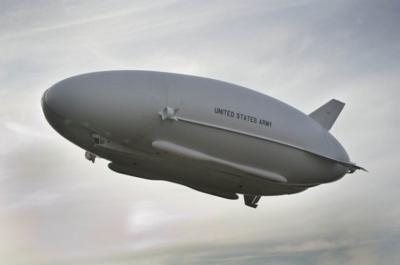Fri, Aug 10, 2012
Medium-Altitude-Long-Endurance Lighter-Than-Air Aircraft Can Operate Manned Or Unmanned
In its first flight, the Army's hybrid air vehicle known as the Long Endurance Multi-Intelligence Vehicle, or LEMV, stayed aloft over Joint Base McGuire-Dix-Lakehurst, NJ, for more than 90 minutes on August 7. The LEMV, like a blimp, is capable of carrying multiple intelligence, surveillance and reconnaissance payloads for more than 21 days at altitudes greater than 22,000 feet. The U.S. Army Space and Missile Defense Command/Army Forces Strategic Command conducted the first flight test of vehicle.

"Murphy Bays" on the LEMV can carry just about any kind of sensor or equipment, and design specifications for the LEMV require the vehicle to provide up to 16 kilowatts of electrical power for those payloads. The LEMV is intended to be used to conduct long-term Intelligence, Surveillance, and Reconnaissance, or ISR, and persistent stare-type missions, and can also be used as a communications relay.
The primary objective of the first flight was to perform a safe launch and recovery of the LEMV. A secondary goal was to verify the flight control system operation. Additional objectives included airworthiness testing and demonstration, as well as system-level performance verification. All objectives were met during the first flight.
The football field-sized LEMV can operate at altitudes greater than 22,000 feet above mean sea level, has a 2,000 mile radius of action, can carry a 2,750 pound ISR payload for more than 21 days, and boasts a fuel consumption that is more than 10 times less than comparable capabilities. Design requirements for the LEMV include providing up to 16 kilowatts of electrical power for payload, as well as runway independence.
The LEMV is designed to be a recoverable and reusable multi-mission platform. It can be forward located to support extended geostationary operations from austere locations and capable of beyond-line-of-sight command and control. During this first flight, the LEMV was manned, though the air vehicle can also operate unmanned.
Following a planned and detailed inspection of the vehicle, there will be additional manned flights.
(Image provided by the U.S. Army)
More News
Abeam An aircraft is “abeam” a fix, point, or object when that fix, point, or object is approximately 90 degrees to the right or left of the aircraft track. Abeam indic>[...]
Aero Linx: The Air Charter Safety Alliance The group, called the Air Charter Safety Alliance, will raise awareness of illegal charter flights among potential customers, charter bro>[...]
“For months, ALPA has been sounding the alarm on the ongoing efforts by some aircraft manufacturers to remove pilots from the flight deck and replace them with automation. To>[...]
Also: uAvionix AV-Link, Does Simming Make Better Pilots?, World Games, AMA National Fun Fly Czech sportplane manufacturer Direct Fly has finished delivering its 200th ALTO NG, the >[...]
“The legislation now includes a task force with industry representation ensuring that we have a seat at the table and our voice will be heard as conversations about the futur>[...]
 ANN's Daily Aero-Term (06.11.24): Abeam
ANN's Daily Aero-Term (06.11.24): Abeam ANN's Daily Aero-Linx (06.11.24)
ANN's Daily Aero-Linx (06.11.24) Aero-News: Quote of the Day (06.11.24)
Aero-News: Quote of the Day (06.11.24) Airborne Affordable Flyers 06.06.24: 200th ALTO, Rotax SB, Risen 916iSV
Airborne Affordable Flyers 06.06.24: 200th ALTO, Rotax SB, Risen 916iSV Aero-News: Quote of the Day (06.12.24)
Aero-News: Quote of the Day (06.12.24)



